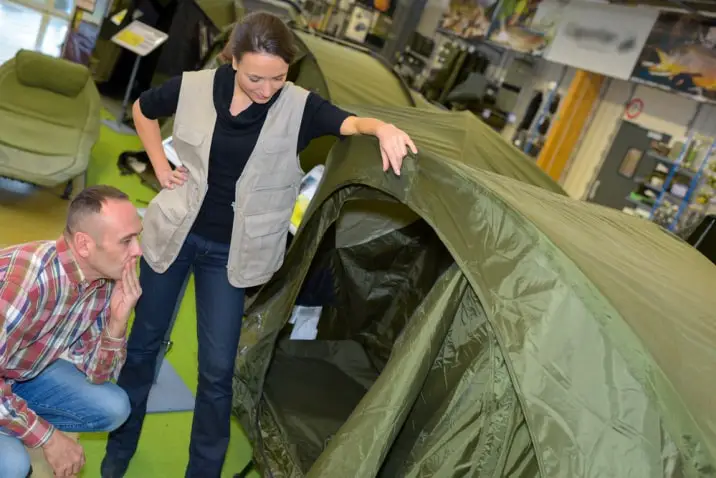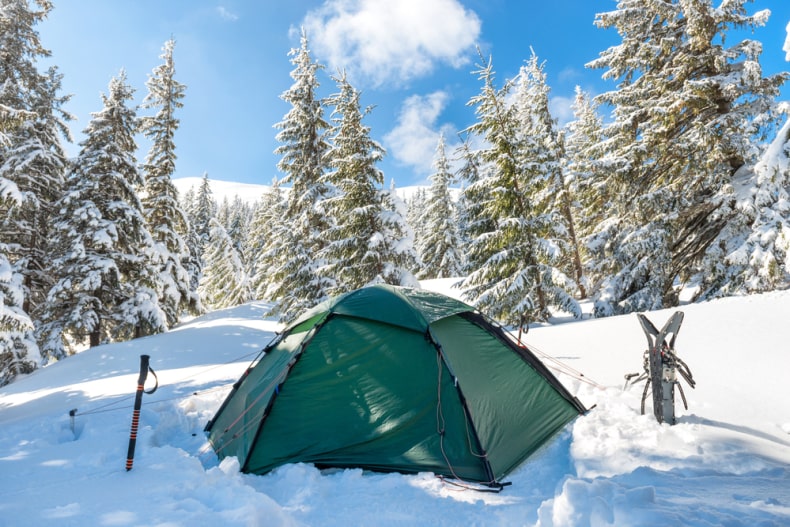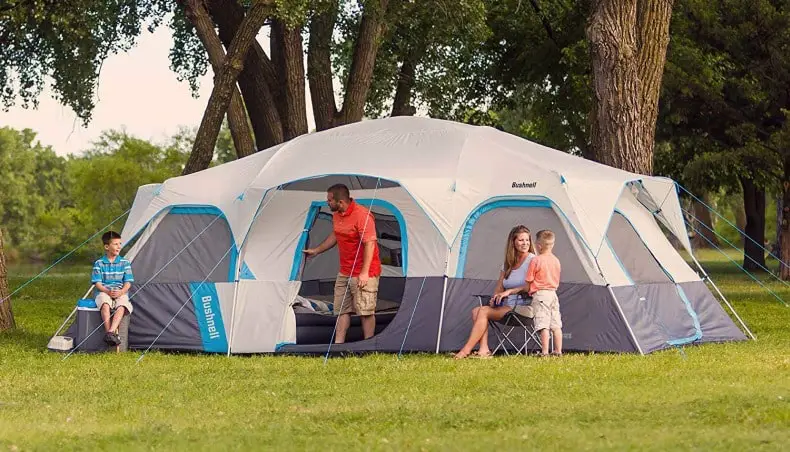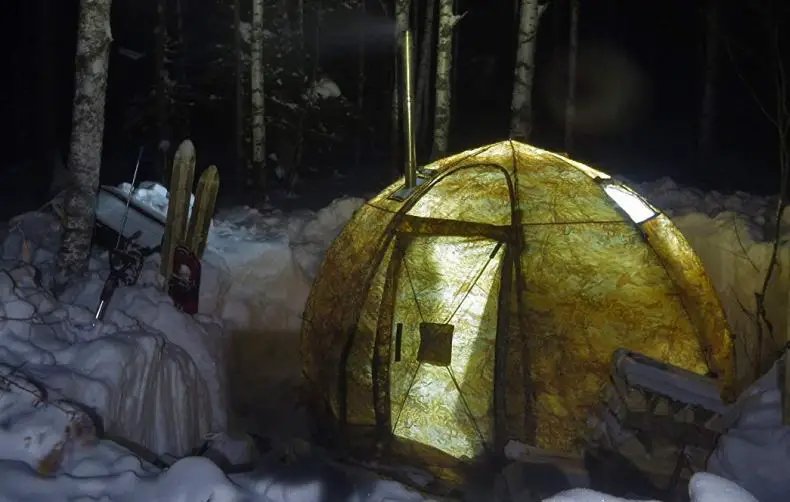When you go camping, you want to make sure whatever tent you plan to use will be capable of handling everything you might face. However, not all tents are capable of doing this and are only cleared for 3 seasons compared to others that are cleared for 4. However, what’s the real difference between the two?
A 3-season tent is usually made to withstand your average conditions associated with normal camping or backpacking. That includes light rain, hail, and even moderately cold weather. 3-season tents are also designed to be light without sacrificing protection or strength. 4-season tents are made to withstand everything and are usually a bit larger.
Most tent experts will tell you that your avid camper will actually have either one, as everything simply depends on the time of year you camp along with where you’re camping. If you were to camp in Southern California during the winter, you’d be fine with a 3-season tent, for example.
That becomes a different story altogether when you plan to camp in Montana during the Winter.
As you can clearly understand, the time of year did not change. Rather, the location did. Thus, a man only camping in Southern Cal is going to experience similar weather all year, none of it extreme enough to need a 4-season tent. A man who only camps in Montana would need one, because of the conditions changing wildly throughout the year.
Table of Contents
3-Season Tents Tend To Be For Backpackers

Most camping or tent experts will tell you that, while it is not a universal rule, 3-season tents are usually utilized more by backpackers. This is due to most backpackers only doing their thing 3 seasons out of the year: Summer, Spring, & Fall.
While some backpackers will go out and about all year, it is not common to see them in the Winter due to conditions being much more difficult. For the rest of the year, you do not have to deal with extreme cold, snow, or ice. Unless you just happen to be in a colder area of the world.
As a result, the best 3-season tents are made to handle a lot of rain and even a lot of wind as both are common worldwide throughout a given year. They are capable of withstanding a lot, yet manage to do all of this in a lightweight package. Which is heavily useful to backpackers, who need their packing load to be as light as possible.
As technology becomes more advanced with these tents, the materials are allowing them to be even lighter while also still being highly protective. The newer “Ultra-Lightweight” tents are a good example of this. The average weight for these tents tends to be 3 to 6lbs.
They also tend to be small enough to fit within a backpack or easily placed somewhere on your standard backpacker’s pack.
You Might As Well Call 4-Season Tents Just A “Winter Tent”

While you can use a 4-season tent at any point throughout the year, most would tell you that they should be called a “Winter Tent.” Why? Because they were ultimately designed for such a purpose and these tent models take from centuries-old concepts to be effective.
Before we all had nice homes to live in, people lived in what would pretty much be considered a tent today. Even armies used to put their major Officers and Generals in luxury tents, yet all of these people were given a tent that could handle any weather they faced.
Many of those tents could handle extreme weather and were usually made from the hide or fur of animals. The most common type that worked best was the hide from Buffalo, Yak, or other bovine types like this. That was due to the thickness it provided, which stands up well against most winter weather conditions.
Tents back then even had openings where you could put an early stove for properly heating the inside of the tent. This kept it warm and toasty inside in spite of potential negative-twenty degree markings.
Nowadays, we do not need tents made from animal hides like this. Although, there are still some made utilizing that. Today, we have tons of great fabric options that can keep tents impressive against all sorts of conditions.
The 4-Season Tent Handles A Lot:
People tend to call them Winter Tents often due to being able to stack up against all sorts of winter weather issues such as sleet, hail, snow, ice, and very high winds. Most tend to be mesh-free, unlike many 3-season tents.
You’ll normally see them built with polyester or nylon in an effort to trap body heat while still keeping wind temperature from getting inside. That is not to say that do not have some level of breathability, as many have vents and open to control condensation issues.
These tents also have rain flaps or vestibules that will go to the ground and can block snow and wind from getting in quite well. There might even be flaps that fold inward to allow snow to pack onto the tent without affecting the stability of the tent itself.
Due to all of this, the frame on a 4-season tent will often be thicker with aluminum or another powerful metal used throughout. Of course, many of these tents take a little longer to put up but are well worth the extra time.
They also traditionally have extra doors, additional guy out points, as well as several indoor gear pockets. Due to a lot of this, weight is typically higher compared to 3-season tents. You’ll usually see them anywhere between 8 and 25lbs.
New tech is cutting this weight down a good bit, however.
Which One Should You Buy?

This can be a loaded question, as it truly all depends on the needs you have compared to others. As we also referenced above, your location and when you camp will have a lot to do with this too. Generally speaking, 4-season tents are the better option just because they can be used all year.
Yet for the person who simply needs to have a lighter load to carry, then you want the 3-season tent more often than not. The big thing is that 3-season tents are not cleared for very cold environments or winter-weather conditions.
Therefore, you’ll be risking your own well-being if you choose to use one in such an environment. Yet if you backpack through Nevada during a Summer period, then your 3-season tent will not be a problem at all. It’s the attempt to do this in Maine during November or December that will hurt you, ultimately.
You need a tent that can help keep you from being affected by the bitter cold, especially if you cannot generate a fire. 3-season tents are not built for that purpose. Naturally, 4-season tents are. Therefore, you want to pick one that best fits your specific needs.
Price Difference:
To be honest, the price difference between 3-season & 4-season tents is generally very little or none at all. In fact, there are many 3-season tents that cost more than some 4-season tents. It is ultimately the brand that tends to be behind a higher or lower price.
Your standard 4-season tent from Coleman will often be cheaper than the same type of tent from Marmot. Yet Coleman is also sold all over the place and is so successful that the brand can lower its cost and still generate a solid bottom line.
There are some newer brands with far superior tents that will cost a good bit more due to their newer stature in the tent brand community. But the price difference will need to be something you consider and if you’re willing to pay the larger cost, especially for a newer brand.
MSR, for example, is not exactly new. They usually sell 3-season tents for $300 to $800. Yet their 4-season tents could be $500 to over $1,000. Coleman can sell for half these prices but might not be as good.
The best thing you can do is price compare, then shop around. Physically go to outdoor stores and check out tents too. This will help you make an informed decision. Price-wise, you’ll be able to get out for a cost that’s likely perfect for you.






